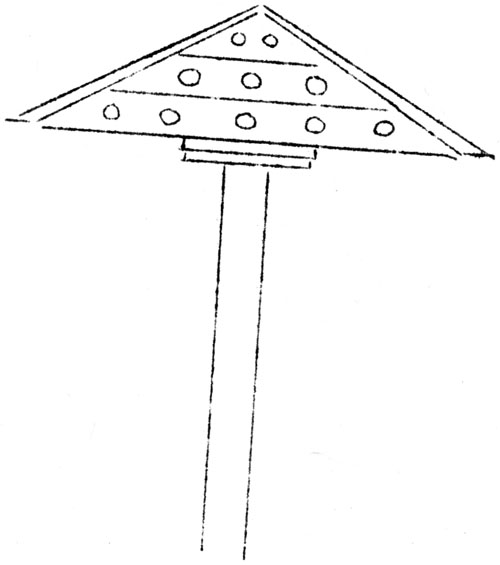|
Home : Quarterly Archives : Volume 6 |
Tredyffrin Easttown Historical Society |
|
Source: 1947 Volume 6 Number 3, Pages 49–50 Franklin Burns the ornithologist Frank L. Burns was Chester County's leading amateur ornithologist but he was known far beyond its borders. The value of his detailed and expert observations on bird migration was recognized in 1931 by the U. S. Biological Survey. In that year he was one of a handful of American birdmen to receive an engraved testimonial - for forty years of continuous cooperation. Mr. Burns was more than a keen observer, for he wrote extensively of his discoveries and read widely in preparing several exhaustive treatises. His 180-page "Monograph on the Broad-winged Hawk" (Wilson Bulletin, Vol. 33, 1911) was considered the most complete description of the life and habits of any bird. His observations and wide reading had led to two earlier very substantial papers, on "The American Crow" (Bulletin No. 5, Wilson Ornithological Chapter, Agassiz Association, 1895), and "A Monograph on the Flicker" (Wilson Bulletin, No. 31, April 1900).
Although he almost invariably did his field work alone, Mr. Burns was active in various ornithological societies. He became a member of the Delaware Valley Ornithological Club in 1891, and helped found the Wilson Ornithological Club, December 3, 1888. He served as editor, treasurer, and president of the latter club which is the second largest ornithological organization in the United States. He was one of a very few men to be elected an Honorary Member of the D.V.O.C. The Chester County birdman developed one field method which has since become widely established. Beginning in 1899 he made an annual census of the birds breeding in a selected area near his home. After three years he published his finding: "A Sectional Bird Census - Taken at Berwyn, Chester County, Pennsylvania During the Seasons of 1899, 1900, 1901" (Wilson Bulletin. Vol. 8, Dec. 1901). In this paper he reported 82 species nesting in this area; less than 100 birds nest in the whole county. The Breeding Bird Census is now an annual activity in almost every part of the United States. Mr. Burns was a frequent contributor to various journals. In addition to the Wilson Bulletin may be mentioned Cassinea, the Osprey, the Oologist, and the Auk. In the last named in 1915 he reported an ornithological occurrence that caused considerable concern in Chester County: "The Cape May Warbler as an Abundant Autumnal Migrant and as a Destructive Grape Juice Consumer at Berwyn, Pa." (The Auk, vol. 32, pp. 231-233, 1915). The tiny birds, smaller than sparrows, and generally rare hereabouts, were unusually numerous in September and October, in 1913 and 1914. They pecked into ripening grapes, drinking the juice, and ruining the fruit. Fifty warblers were counted in a single vine in two days. The damage was estimated at several hundred dollars in the Paoli-Berwyn area. There are no published records of further incidents of this nature. An important contribution to local ornithological history was made by Burns in 1917 when he published "Miss Lawson's Recollections of Ornithologists" (The Auk, vol. 34, pp. 275-282, 1917). Malvina Lawson was the daughter of the engraver, Alexander Lawson, who prepared the plates for Alexander Wilson's American Ornithology and many other important scientific works. In gathering data on Wilson, Burns had read many of Miss Lawson's letters describing contemporary persons and their doings. He made extensive notes and when, later, the letters were lost he was able to salvage much of interest from his notes. Her colorful comment was highly descriptive, sometimes quite amusing. In 1919, culminating 35 years of intensive birding in southern and eastern Chester County, Burns published an attractive little book, "The Ornithology of Chester County, Pennsylvania" (The Gorham Press, Boston, pp. 1-122, 1919). "Probably no county in the United States can boast of as many bird-lists as Chester County, Pa.," commented Witmer Stone, the Academy of Natural Science1s bird authority who complimented Burns on his work, by far the most complete of the many lists. Listed were 247 species, of which 98 were known to nest in the county. The chief criticisms leveled at the book were editorial ones, not ornithological. In 1915 Burns had called attention to the lack of knowledge about the period of song and of incubation of many of our commonest birds ("Comparative Periods of Deposition and Incubation of some North American Birds". Wilson Bulletin, No. 90, pp. 275-286, March 1915). His last important paper dealt further with this subject. He wrote on "The Song Periods of Some Common Southeastern Pennsylvania Birds in Comparison with their Seasonal Reproductive Cycles" (Oologist, vol. 54, pp. 114-130, October 1937). Included in this paper is an ingenious table giving the approximate duration of the song period and of the nesting period of 25 common birds. Frank Burns seldom travelled beyond the confines of Chester County, and he worked alone. But he carried on a voluminous correspondence with the most active birdmen of his time, and his work was recognized and respected by them. His contributions to ornithology will be long remembered. |
